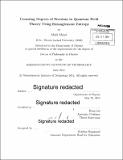| dc.contributor.advisor | Hong Liu. | en_US |
| dc.contributor.author | Mezei, Márk (Márk Koppany) | en_US |
| dc.contributor.other | Massachusetts Institute of Technology. Department of Physics. | en_US |
| dc.date.accessioned | 2014-11-04T21:33:07Z | |
| dc.date.available | 2014-11-04T21:33:07Z | |
| dc.date.copyright | 2014 | en_US |
| dc.date.issued | 2014 | en_US |
| dc.identifier.uri | http://hdl.handle.net/1721.1/91389 | |
| dc.description | Thesis: Ph. D., Massachusetts Institute of Technology, Department of Physics, 2014. | en_US |
| dc.description | 141 | en_US |
| dc.description | Cataloged from PDF version of thesis. | en_US |
| dc.description | Includes bibliographical references (pages 199-208). | en_US |
| dc.description.abstract | We devote this thesis to the exploration of how to define the number of degrees of freedom in quantum field theory. Intuitively, the number of degrees of freedom should decrease along the renormalization group (RG) flow, and should be independent of the RG scale at a conformal fixed point. We argue that a refinement of entanglement entropy is a promising candidate for such measure. Indeed, in two and three spacetime dimensions the number of degrees of freedom defined this way can be proven to monotonically decrease under RG flows. Firstly, we define renormalized entanglement entropy (REE) and show that it is finite in the continuum limit in a renormalizable field theory. We argue that it is most sensitive to degrees of freedom at a scale determined by the size of the entangling region, and interpolates between the ultraviolet and infrared RG fixed point vales. We discuss how it can be used to count the degrees of freedom at a given scale. Secondly, we test whether REE is monotonic along the RG flow. In two dimensions it was known to be monotonic before our study. In higher dimensions, we study REE in free theory examples and in the framework of holography. Holography is tailormade for the study of RG flows, and allows an efficient determination of entanglement entropy. We make use of its power and flexibility to conjecture that in three spacetime dimensions REE is monotonic, while in four dimensions it is neither monotonic nor positive. Subsequent work has proven the conjecture. Thirdly, we count the degrees of freedom in three-dimensional superconformal field theories that are the infrared limit of supersymrnetric gauge theories with matter. Supersymmetric localization reduces the computation of entanglement entropy to a matrix integral. We solve this matrix model in the large N number of colors limit using two different methods; in a saddle point approximation we obtain the next-to-leading order expression in 1/N, while mapping the matrix model to a non-interacting Fermi gas enables us to determine the result to all orders in 1/N. We match the leading piece with N3/ 2 scaling - a strong coupling phenomenon in the field theory - with the holographic duals of these theories. Establishing a measure for the number of degrees of freedom provides nonperturbative understanding of RG fixed points and flows. Our hope is that the constraints coming from RG monotonicity can be efficiently used to constrain the long-distance physics of certain systems of interest. The first applications are only starting to emerge. | en_US |
| dc.description.statementofresponsibility | by Márk Mezei. | en_US |
| dc.format.extent | 208 pages | en_US |
| dc.language.iso | eng | en_US |
| dc.publisher | Massachusetts Institute of Technology | en_US |
| dc.rights | M.I.T. theses are protected by copyright. They may be viewed from this source for any purpose, but reproduction or distribution in any format is prohibited without written permission. See provided URL for inquiries about permission. | en_US |
| dc.rights.uri | http://dspace.mit.edu/handle/1721.1/7582 | en_US |
| dc.subject | Physics. | en_US |
| dc.title | Counting degrees of freedom in quantum field theory using entanglement entropy | en_US |
| dc.type | Thesis | en_US |
| dc.description.degree | Ph. D. | en_US |
| dc.contributor.department | Massachusetts Institute of Technology. Department of Physics | |
| dc.identifier.oclc | 893433139 | en_US |
